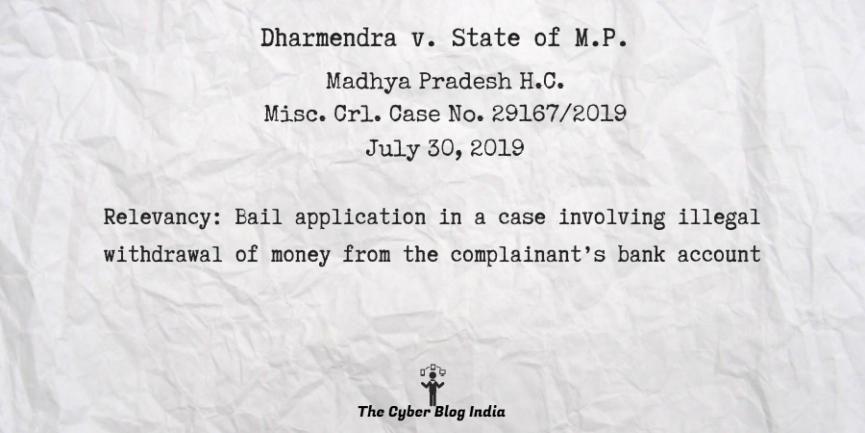Dharmendra v. State of M.P.

Dharmendra v. State of M.P.
In the High Court of Madhya Pradesh
Misc. Crl. Case 29167/2019
Before Justice S.K. Awasthi
Decided on July 30, 2019
Relevancy of the case: Bail application in a case involving illegal withdrawal of money from the complainant’s account
Statutes and Provisions Involved
- The Information Technology Act, 2000 (Section 66C, 66D)
- The Indian Penal Code, 1860 (Sections 120B, 420, 467, 468, 471)
- Indian Evidence Act, 1872 (Section 27)
- The Code of Criminal Procedure, 1973 (Section 439)
Relevant Facts of the Case
- The complainant alleged that certain unknown people withdrew ₹87,000 from her bank account.
- According to her statement, two unknown people came to her house and asked if she was getting the benefit of the widow pension scheme. She replied in affirmative, and they took pictures of her Aadhar card and thumb impression. From the same day, the amount started being deducted from her account.
- According to the ensuing investigation, a co-accused was the mastermind. They opened various bank accounts by tricking the innocent and uneducated. He transferred the money from one account to another, later using it for withdrawal.
Prominent Arguments by the Advocates
- The applicant’s counsel submitted that the applicant is just 22-year-old and is innocent. He isn’t named in the FIR, nor has he been identified during the Test Identification Parade. None of the witnesses had seen the applicant with the co-accused, visiting houses of the victims. The only basis of his implication is evidence that is inadmissible under Section 27 of the Indian Evidence Act, 1872. Although ₹40,000 has been recovered from his possession, it isn’t sufficient to connect him to any crime.
- The respondent’s counsel submitted that no sufficient ground has been made out for bail.
Final Decision
- Application allowed.
- Bail was granted, subject to certain conditions.
This case summary has been prepared by Akshita Rohatgi, an undergraduate student at the University School of Law and Legal Studies, GGSIPU, during her internship with The Cyber Blog India in January/February 2021.
